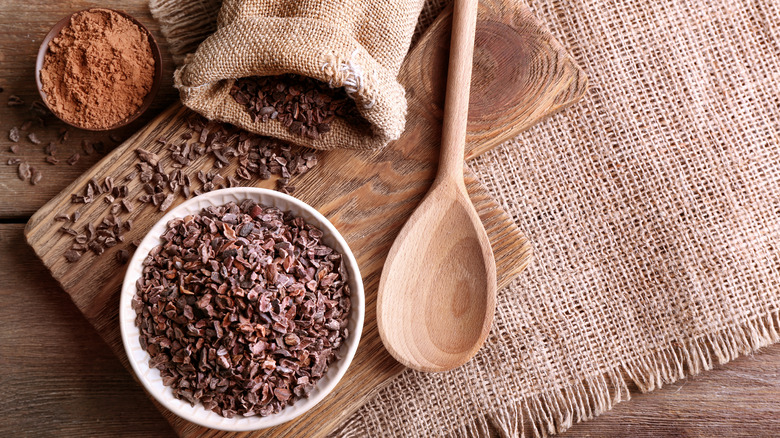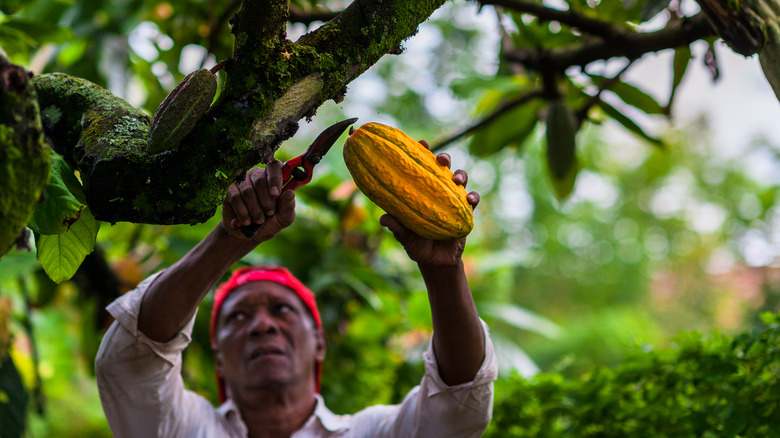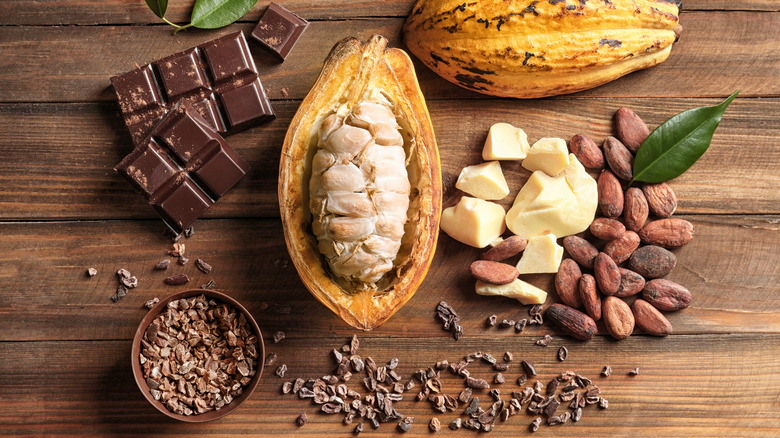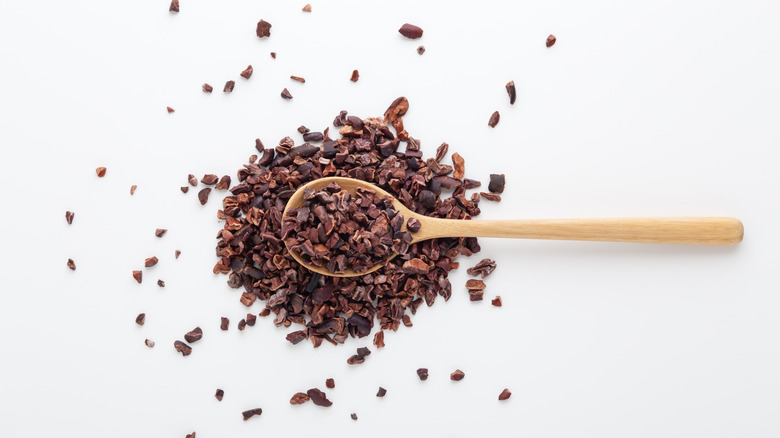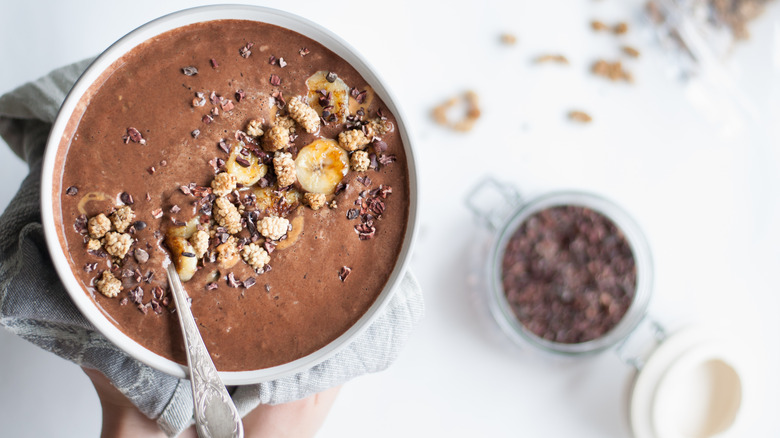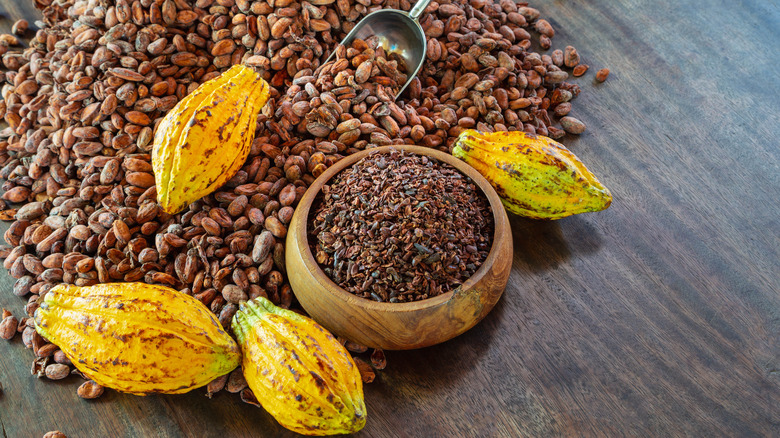What Are Cocoa Nibs And How Do You Eat Them?
Cocoa nibs — you've heard of them, you've seen them at the health food store, you might've even tried them, but do you know what they are? With a name like that, it's fair for you to assume that they're some form of chocolate. But chocolate lovers should be wary. Bitter, crunchy, and without a hint of sweetness, one bite of cocoa nibs could have even the most loyal chocolatier questioning the world as they know it. But before you swear off the nibs for good, you should give them a chance.
Cocoa nibs are pure shards of cocoa beans that are made from the cores of cacao pods, nothing more and nothing less. Instead of being ground a mixed with sugar, milk, and emulsifiers in the typical chocolate-making process, the cocoa beans used for cocoa nibs are broken into pieces, pulverized, bagged, and sold exactly as they are. They're probably the most unprocessed cocoa product you can find, with a flavor to match.
Yes, cocoa nibs are bitter, but their taste is much more complex than your average dark chocolate. With intense fruity and earthy notes, cocoa nibs are the secret ingredient to amplifying the chocolatey-ness of even the most chocolatey desserts — but they're also delicious enough to enjoy in their own right.
How are cocoa nibs made?
Based on the name alone, it's obvious to assume that cocoa nibs have some relationship to chocolate — and you'd be correct in that assumption. While they may not resemble your favorite chocolate bar, cocoa nibs are a by-product of the chocolate-making process. Chocolate producers separate the cocoa bean husks from the seeds by taking the beans of the cocoa fruit, roasting them, and breaking them apart. But before they become nibs, the seeds are fermented for two to six days. The fermentation removes some — not all — of the antioxidants found in the pulp surrounding the seeds, making them less bitter and giving them the fudge-like flavor that chocolate is known for.
After fermentation, the seeds are dried and broken into small pieces called nibs. However, rather than grinding them into chocolate liquor and mixing them with milk, sugar, and an emulsifier such as vegetable oil, the nibs are cleaned, packaged, and shipped just as they are. Depending on the manufacturer, they may also be roasted to give them a more refined and concentrated flavor. While you could technically purchase cocoa nibs to make your chocolate at home, it isn't recommended because your blender won't achieve the same consistency. Besides the addition of milk and sugar, other steps in the manufacturing process make cocoa nibs very different from chocolate, both in taste and nutrition.
Cocoa nibs vs. chocolate
Now that we understand what makes cocoa nibs and chocolate similar, it'd also be beneficial to understand how they differ. Unsurprisingly, the two are different in more ways than one. While cocoa nibs are simply made from cracked beans, chocolate is made from a mixture of the fat from the cocoa beans, also known as cocoa butter, milk, sugar, and emulsifying vegetable oils.
However, if you're someone who expects a rich and smoother taste, they may not fulfill all of your chocolate cravings. When making chocolate, the cocoa nibs are ground for hours on end. The process allows the cocoa nibs to release different acids, making the final chocolate product taste much less acidic with a more smooth and balanced flavor. Cocoa nibs, on the other hand, contain all of those acids. Without the addition of milk and sugar, this gives them a taste that's nuttier, earthier, and much more bitter than chocolate, whether it's milk or dark.
What do cocoa nibs taste like?
Once you understand that, despite coming from the same plant, cocoa nibs are not the same as chocolate, you can begin to appreciate them for what they are. Being pure, pulverized cocoa seeds, cocoa nibs have a bitter taste without a hint of sweetness compared to even the darkest variety of chocolate. Their flavor is concentrated into shards that, when bitten into, provide an impressive crunch that is harder than most nuts but explodes with both fruity and earthy flavors.
So, if you tend to prefer the taste of sweet, smooth milk chocolate, cocoa nibs may be a bit of a leap in flavor for you. Especially when roasted, cocoa nibs have an intense and tart flavor that can shock your taste buds. But if you're a chocolate lover who enjoys dark chocolate's rich and complex flavors, cocoa nibs could be the next level in your chocolate-tasting experience. Whether topped on your chocolate ice cream or infused into your morning brew, cocoa nibs will surely send you into a richer, bolder, and more pronounced chocolate dimension.
How to cook with cocoa nibs
In all of their intense flavor complexity, cocoa nibs can be enjoyed in the simplest of ways. Even after roasting in the oven for 5 to 10 minutes, giving them an even more refined and bold taste, cocoa nibs can be sprinkled over your ice cream, mousse, oatmeal, or yogurt parfait as a garnish. Even if you're not a fan of dark chocolate, cocoa nibs will make a great superfood boost in your fruit smoothies, bowls, and trail mix, where their crunchy texture works particularly well when substituted for nuts, granola, or chocolate chips with the bonus of being dairy and nut-allergen-friendly. You can even eat them by the handful if you like.
Cocoa nibs also work great in baking recipes, just note that cocoa nibs still contain fat in the form of cocoa butter. While cocoa nibs can be substituted for chocolate chips at a 1:1 ratio, you may need to adjust some recipes to account for their fat content. In desserts, cocoa nibs go well with the flavors of fresh and dried fruit, caramel, coffee, and nuts, but they're especially impactful when used in anything chocolate, as they help to bring out more bittersweet notes. For this reason, some people like to infuse dark chocolate into the base of their homemade chocolate ice cream. In a similar way, cocoa nibs can be infused into milk, cream, and custard to add chocolatey flavors to desserts.
Where to buy cocoa nibs
These days, cocoa nibs can be found in higher-end food stores. They're generally stored along the shelves of the baking aisle, usually somewhere around the chocolate chips. If they're not there, they may also be hiding in the trail mix aisle with the dried fruit and nuts. Keep in mind that cocoa nibs are sold both roasted and raw, with the roasted variety carrying the more intense flavors. However, if the raw cocoa nibs are all that's available, you can always take them and roast them in the oven yourself, just as you would any other nut or seed.
Just like when you're shopping for sustainable coffee, it's recommended that you opt for organic and ethically sourced cocoa nibs. The USDA Organic, Rainforest Alliance, and Fair Trade Certified seals are good indicators to look for to support cocoa farming that is sustainable and humane, but they're also indicative of the quality of the cocoa nibs. Low-quality cocoa nibs are often overpowered with bitterness, and while you may save a buck, you'll miss out on the flavor complexity that high-quality cocoa nibs deliver.
All that said, if you can get cocoa nibs from a chocolatier in your area — 100% go for it. Otherwise, certified organic nibs are the way to go.
Nutritional information about cocoa nibs
Cocoa nibs contain an impressive amount of nutrients and health benefits for their size. Not only are they naturally low in sugar, with only 1 gram per serving, but cocoa nibs are also found to provide a substantial amount of fiber, protein, and healthy fats, making them much more nutrient-dense and filling than other cocoa products on the market, per Healthline. With next to no sugar and enough fiber to slow digestion, R.D. Megan Byrd explains to Martha Stewart that cocoa nibs are also a blood sugar-friendly alternative to chocolate — one that anyone can enjoy and, in turn, reap the benefits of.
But cocoa nibs are also full of minerals, including copper, iron, phosphorus, zinc, and magnesium, a mineral that can lack in many people's diets (via NIH). However, most cocoa nibs' health benefits can be linked to the potent plant compounds they contain — particularly antioxidants. These components can be found in many cocoa products, but especially in cocoa nibs, and are found to reduce the oxidative stress that can lead to other chronic conditions and diseases.
